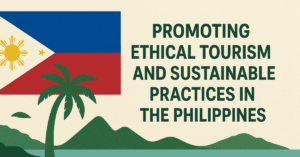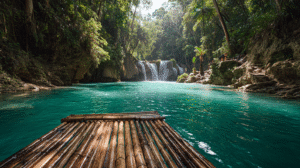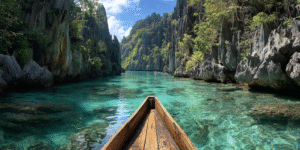Did you know that Siargao Island is more than just a single landmass? It’s an archipelago of 48 islands and islets, protected under one of the country’s largest marine conservation areas. While its fame is built on the perfect barrel of the Cloud 9 wave, the reality of Siargao is far more diverse, offering a rich tapestry of experiences for every kind of traveler, not just the seasoned surfer.
The key to a great trip here is understanding the island’s rhythm—the tides, the seasons, and the balance between its world-famous spots and quieter corners. Whether you’re planning a week-long adventure or a short getaway, this guide covers the essential things to do in Siargao, blending marquee attractions with local insights.
Explore by Land and Sea
The classic Siargao island-hopping tour is popular for a reason, but knowing what to expect makes it better. The typical trip covers three destinations: Naked Island, a completely bare sandbar; Guyam Island, a tiny circle of sand and palms; and Daku Island, the largest of the three, known for its beachfront cottages and fresh seafood lunches. A crucial tip for Daku: ask your boatman about a “paluto” service. You can buy fresh fish or shellfish from local fishermen and have a family cook it for you for a small fee (around ₱300-500 PHP / $5-9 USD). It’s the freshest meal you’ll have.
One of the most unique tourist attractions in Siargao is the Magpupungko Rock Pools in Pilar. These clear, turquoise pools are exposed only during low tide, creating natural swimming holes perfect for cliff jumping and snorkeling. The number one mistake travelers make is ignoring the tide schedule. Arrive at high tide, and the pools are completely submerged and inaccessible. Check the tides online or ask a local before you hire a scooter for the 45-minute ride from General Luna. The entrance fee is around ₱50 PHP ($1 USD).
For another stunning water experience, head to Sugba Lagoon. The journey itself, a boat ride through a vast mangrove forest—one of the largest in the Philippines—is part of the appeal. Once there, a two-story pontoon house serves as a hub for renting kayaks, stand-up paddleboards, and simply jumping into the serene, emerald waters. It can get crowded, so consider booking a private tour that leaves General Luna early to beat the main rush.
Connect with the Island’s Culture and Flavors
General Luna is the island’s vibrant heart, but it’s more than just a strip of resorts and restaurants. It’s a living community where local fishing families and international entrepreneurs coexist. To appreciate this, wake up early and visit the General Luna Public Market. It’s a sensory overload of fresh tuna, local produce, and the chatter of daily life. It’s a great place to understand the island’s economic backbone.
The food scene in Siargao has exploded, offering everything from roadside barbecue stalls grilling chicken for ₱80 PHP ($1.50 USD) to high-end dining. For a classic Siargao experience, head to Kermit Siargao, a long-standing favorite known for its pizza and Italian dishes. For something healthier, Shaka Cafés offers iconic smoothie bowls with a view of Cloud 9. Don’t overlook the local carinderias (small eateries) for authentic, budget-friendly Filipino meals like adobo and sinigang.
Find Your Adventure
So, what to do in Siargao if you’re seeking a thrill? Surfing is the obvious answer. While Cloud 9 is a powerful, fast-breaking reef wave strictly for experienced surfers, the surrounding area has plenty of beginner-friendly spots. Head to Jacking Horse, where gentle, rolling waves are perfect for your first lesson. Instructors are readily available along the beach, with lessons typically costing ₱500-₱1,000 PHP ($9-18 USD) per hour, including board rental.
Beyond the surf, the Maasin River Palm Tree Swing has become an Instagram icon. While the photo-op is fun, the experience supports the local community that maintains the site. For a small fee (around ₱20 PHP), you can swing out and drop into the cool river water. Another worthy adventure is the Tayangban Cave Pool. This requires a bit of courage, as you’ll wade through chest-deep water in a dark cave with a guide, eventually emerging into a beautiful cenote-like pool on the other side. It’s a short but memorable caving experience.
For Those with More Time
If your schedule allows for a full-day trip, consider Sohoton Cove National Park on nearby Bucas Grande Island. It’s often described as a smaller version of Palawan’s lagoons. The journey takes a couple of hours by boat, but the reward is a maze of limestone karsts and emerald waters. The highlight for many is the Tojoman Lagoon, a stingless jellyfish sanctuary (best visited between March and June). This isn’t a quick trip; it’s a commitment, but one that showcases the region’s incredible biodiversity.
A Practical Siargao Travel Guide
- Getting Around: Renting a scooter (around ₱350-500 PHP / $6-9 USD per day) offers the most freedom. Always wear a helmet. For shorter distances, tricycles and habal-habal (motorcycle taxis) are plentiful.
- When to Go: The peak season is the dry season, from March to October. For surfers, the best swells arrive from September to November, which can also bring more rain.
- Money: While more ATMs are available now, they can be unreliable, especially outside General Luna. It’s wise to bring sufficient cash. Many smaller establishments do not accept credit cards.
- Connectivity: Wi-Fi can be inconsistent. Buying a local SIM card (Smart or Globe) upon arrival at the airport is your best bet for staying connected.
- Be a Responsible Traveler: Siargao is a community actively fighting to reduce plastic waste. Pack a reusable water bottle and tote bag. Respect the local environment by not touching or stepping on coral during island hopping or snorkeling. These small actions help preserve the island’s beauty.
Ultimately, the best things to do in Siargao are the ones that connect you to its powerful natural energy. It’s an island that rewards the curious, the respectful, and the adventurous. It asks you to slow down, watch the tides, and maybe even try catching a wave of your own. What will you discover beyond the shoreline?




